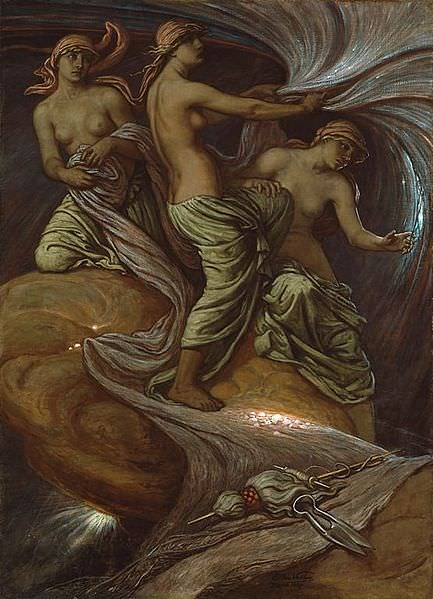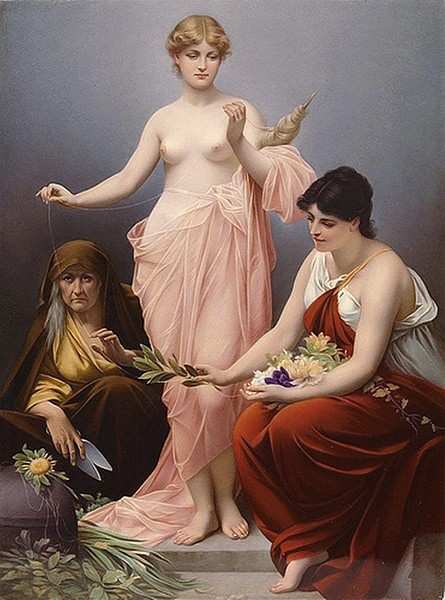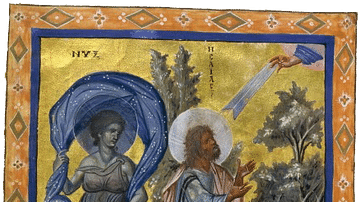
The Fates (also known as the Moirai in Greek mythology) are three sister goddesses responsible for assigning destinies to mortals at their birth, a human's lifespan, and the timing of their death. The golden thread they spin represents each individual's fate, and when the thread is broken, it signifies the end of a human's life.
The Fates were said to be the daughters of either Nyx (the Night) or of Zeus and Themis (Law and Justice). There were three Fates: Clotho (the Spinner), Lachesis (the Measurer/Apportioner), and Atropos (the Unbending/Inflexible one). The Roman equivalent of the Fates are the Parcae.
The Fates
As the daughters of the Night, the Fates ruled the dark destinies of humankind. A golden thread represented each person's life and destiny that the Fates spun on their spinning wheel. Once a person's life ended, the sisters cut the thread. Clotho spun the thread, Lachesis (the allotter of time) measured it, and Atropos cut it when it was time for someone to die. The gods themselves dared not to interfere with the Fates once they had decided a person's fate, meaning that they were unable to save their mortal children's lives or the lives of their favourite mortals.
The Three Fates developed from one singular Moira (Fate or Destiny), who was mentioned in Homer's (c. 750 BCE) Iliad as spinning the thread for Hector, prince of Troy. Although the Fates are not featured prominently in any myth, they play a small yet crucial role in various stories. They interacted with multiple gods, including Hermes, who was said to have assisted the Fates in creating the alphabet. They were also present at the birth of various gods and mortals. They only took action in myths when they needed to intervene with a person's fate.
In art, the Fates were originally portrayed as attractive women. However, in later forms of art, they started to be shown as older women with a serious demeanour and holding a spindle or the dice of fate, or sometimes writing down the fate of humans. In literature, they tended to be depicted as older women.
Birth & Family
Depending on the source, the Fates are either the daughters of Nyx (Night) or Zeus and Themis (Law and Justice). Hesiod (c. 700 BCE) lists the Fates as Nyx's fatherless daughters in his Theogony:
She bore the Destinies and ruthless Fates,
Goddesses who track down the sins of men
And gods, and never cease from awful rage
Until they give the sinner punishment.(219-222)
As daughters of Nyx, the Fates were sisters of the dark forces of the world, including Blame, Sad Distress, Nemesis and Strife. Later in the Theogony, the Fates were mentioned as the daughters of Zeus and Themis.
And shining Themis was second wife.
She bore the Horae: Order, blooming Peace,
And Justice, who attend the works if men,
And then the Fates, to whom wise Zeus has paid
The greatest honour: Clotho, Atropos,
Lachesis, who give men all good and bad.(902-907)
It is believed that the Fates being a daughter of Zeus and Themis, was written after Hesiod's time, possibly added by an unknown writer to provide a translation to Hesiod's Catalogue of Women.
Although Zeus claimed to be their father and called himself 'the Leader of the Fates', some ancient writers did not take his claim seriously, including Herodotus (c. 484-425/413 BCE) and Plato (c. 428/427-348/347 BCE).
The Revolt of the Giants & Typhon
Gaia (Earth) was so angered by the victory of the Titans in the Titanomachy that she gave birth to the Giants with Uranus (Heaven). They were fearsome beings with hair falling from their head and cheeks and feet made from dragons' scales. An oracle stated that the gods could not kill the Giants; however, if the gods fought along a mortal ally, they would be able to be killed. So the great Greek hero, Hercules, joined the fight alongside the gods.

Even the Fates joined the battle, fighting with bronze clubs and killing the Giants Agrios and Thoon. The rest of the Giants were killed by Zeus. After the Giants were destroyed, Gaia conceived Typhon, a half-man, half-beast, in an act of vengeance. He surpassed all the other children of Gaia in size. He unleashed a vicious attack on the heavens, causing the gods to flee to Egypt, where they transformed into animals to hide from him. Zeus attacked Typhon with his thunderbolts from afar and engaged him in hand-to-hand combat once he had been weakened. Typhon managed to trap Zeus in his coils and cut his tendons from his hands and feet, which he hid in a bear's skin.
Hermes returned the tendons to Zeus and, after getting his strength back, he pursued Typhon to Mount Nysa, where the Fates tricked him into eating poisonous fruit, claiming that it would make him stronger. While escaping across the Sicilian sea, a weakened Typhon was finally killed after Zeus hurled Mount Etna at him.
The Fates & Meleager
Meleager was a Greek hero and the son of Oineus, the king of Calydon and his wife Althaia, the daughter of Thestios, a king of Anatolia (Asia Minor). When Meleager was seven days old, the Fates appeared and declared that Meleager would die when the log that was burning in the hearth had stopped burning. Full of despair, Althaia grabbed the log from the fire and hid it away in a chest in a desperate attempt to prevent his death.
Meleager grew into a strong man but made a fatal mistake when he forgot to honour Artemis during the annual harvest. A furious Artemis sent a large and ferocious boar that caused havoc. A hunt was organised to kill the beast, with the bravest men in Greece taking part, including Meleager. Atalanta, the Greek heroine, also took part in the hunt and was the first to strike the boar, with Meleager landing the killing blow. He gave the skin of the boar to Atalanta, which caused an uproar amongst the sons of King Thestios, who believed that the prize should have gone to a man. Furious, Meleager killed the sons of Thestios, angering his mother, who mourned the loss of her brothers. In her distress, she removed the log from the chest and rekindled it, resulting in Meleager's death, just as the Fates proclaimed.
The Fates & Admetus
Admetus, king of Pherae, wished to marry Alcestis, the most beautiful daughter of King Pelias of Iolcus. However, first, he would need to pass a test – to yoke a wild boar and lion to a chariot and drive them around a race course. So Admetus enlisted the help of his friend Apollo, who Zeus had appointed his herdsman.
Victorious, Admetus made the foolish mistake of forgetting to make the customary sacrifice to Artemis before he married Alcestis. As a result, the goddess punished him by filling his marriage bed with snakes. Apollo intervened and made a deal with Artemis; that on the day of Admetus' death, he would be spared if a family member died instead of him.
The day of Admetus' death came when Hermes summoned him to Tartarus (the deepest part of the Underworld). Apollo delayed his death by getting the Fates drunk and persuaded them to let somebody else die in his place.
The Fates & the Birth of Hercules
The Fates were present when Alcmene was in labour with Hercules, along with Eileithyia, the goddess of childbirth, and Galinthias, a childhood friend of Alcmene. The Fates and Eileithya were doing their best to stop Alcmene from giving birth to appease Hera. Galinthias, seeing how much pain her friend was in, lied to the goddesses and told them that a male child had been born to Zeus and their divine privileges had been revoked.
The Fates panicked and stopped Alcemene's pain, allowing Hercules to be born. But, like all deities, the Fates did not take kindly to being tricked and took away Galinthias' identity as a woman and transformed her into a weasel who undertook grotesque sexual and reproductive activities.
Worship & Legacy
According to Pausanias (c. 115 to c. 180 CE), the Fates had an altar in the grove of the Eumenides at Sicycon (Corinth), where they received offerings. He also mentioned a sanctuary in Thebes that was located between the sanctuaries of Themis and Zeus Agoraios and was most likely in the open air since he talks about there being no statues or reliefs present. There may have been a temple where the Fates, Demeter, and Persephone were worshipped together or three separate temples dedicated to each, located in the same area. During the annual festival, pregnant sheep were sacrificed, honey and water libations were poured, and flowers were worn instead of myrtle wreaths in honour of the Fates and other goddesses.
The three Fates lend their names to three separate asteroids: 97 Klotho, 120 Lachesis, 273 Atropos, which are all located in the central asteroid belt and orbit between Mars and Jupiter.









